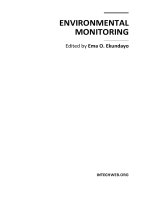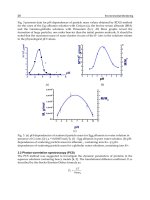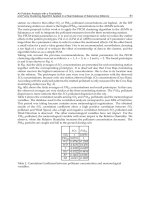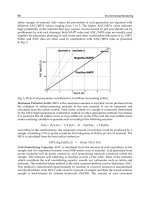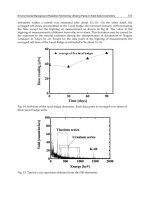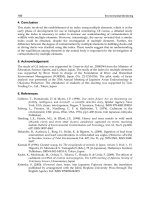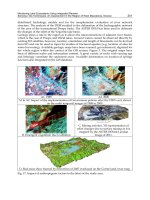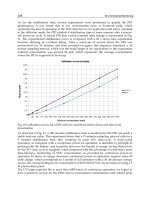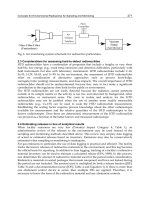ADVANCED ENVIRONMENTAL MONITORING 2
Bạn đang xem bản rút gọn của tài liệu. Xem và tải ngay bản đầy đủ của tài liệu tại đây (8.56 MB, 432 trang )
ADVANCED ENVIRONMENTAL MONITORING
Advanced Environmental
Monitoring
Edited by
Young J. Kim
Gwangju Institute of Science and Technology (GIST),
Gwangju,
Korea
and
Ulrich Platt
University of Heidelberg,
Heidelberg,
Germany
A C.I.P. Catalogue record for this book is available from the Library of Congress.
ISBN 978-1-4020-6363-3 (HB)
ISBN 978-1-4020-6364-0 (e-book)
Published by Springer,
P.O. Box 17, 3300 AA Dordrecht, The Netherlands.
www.springer.com
Cover images © JupiterImages Corporation 2007
Copyright to book as a whole © Springer
Chapter 2 figures © Arcadis, Durham, NC, USA
Chapter 16 © Department of Defence, Government of Canada
Printed on acid-free paper
All Rights Reserved
© 2008 Springer
No part of this work may be reproduced, stored in a retrieval system, or transmitted in any form or by
any means, electronic, mechanical, photocopying, microfilming, recording or otherwise, without written
permission from the Publisher, with the exception of any material supplied specifically for the purpose
of being entered and executed on a computer system, for exclusive use by the purchaser of the work.
Contents
Contributors xi
Preface xxi
Section 1 Atmospheric Environmental Monitoring
Chapter 1 Air Pollution Monitoring
Systems—Past–Present–Future 3
U. Platt
Chapter 2 Radial Plume Mapping: A US EPA Test
Method for Area and Fugitive Source Emission
Monitoring Using Optical Remote Sensing 21
Ram A. Hashmonay, Ravi M. Varma, Mark T. Modrak,
Robert H. Kagann, Robin R. Segall, and Patrick D. Sullivan
Chapter 3 MAX-DOAS Measurements of ClO, SO
2
and NO
2
in the Mid-Latitude Coastal Boundary Layer
and a Power Plant Plume 37
Chulkyu Lee, Young J. Kim, Hanlim Lee, and Byeong C. Choi
Chapter 4 Laser Based Chemical Sensor Technology:
Recent Advances and Applications 50
Frank K. Tittel, Yury A. Bakhirkin, Robert F. Curl,
Anatoliy A. Kosterev, Matthew R. McCurdy,
Stephen G. So, and Gerard Wysocki
v
Chapter 5 Atmospheric Monitoring With Chemical Ionisation
Reaction Time-of-Flight Mass Spectrometry
(CIR-TOF-MS) and Future Developments:
Hadamard Transform Mass Spectrometry 64
Kevin P. Wyche, Christopher Whyte, Robert S. Blake,
Rebecca L. Cordell, Kerry A. Willis, Andrew M. Ellis,
and Paul S. Monks
Chapter 6 Continuous Monitoring and the Source Identification of
Carbon Dioxide at Three Sites in
Northeast Asia During 2004–2005 77
Fenji Jin, Sungki Jung, Jooll Kim, K R. Kim, T. Chen,
Donghao Li, Y A. Piao, Y Y. Fang, Q F. Yin,
and Donkoo Lee
Chapter 7 Aircraft Measurements of Long-Range
Trans-Boundary Air Pollutants over Yellow Sea 90
Sung-Nam Oh, Jun-Seok Cha, Dong-Won Lee,
and Jin-Su Choi
Chapter 8 Optical Remote Sensing for Characterizing
the Spatial Distribution of Stack Emissions 107
Michel Grutter, Roberto Basaldud, Edgar Flores,
and Roland Harig
Section 2 Atmospheric Environmental Monitoring
Chapter 9 Mass Transport of Background Asian Dust Revealed
by Balloon-Borne Measurement: Dust Particles
Transported during Calm Periods by Westerly
from Taklamakan Desert 121
Y. Iwasaka, J.M. Li, G Y. Shi, Y.S. Kim, A. Matsuki,
D. Trochkine, M. Yamada, D. Zhang, Z. Shen,
and C.S. Hong
Chapter 10 Identifying Atmospheric Aerosols with
Polarization Lidar 136
Kenneth Sassen
Chapter 11 A Novel Method to Quantify Fugitive Dust Emissions
Using Optical Remote Sensing 143
Ravi M. Varma, Ram A. Hashmonay, Ke Du, Mark J. Rood,
Byung J. Kim, and Michael R. Kemme
vi Contents
Chapter 12 Raman Lidar for Monitoring of Aerosol Pollution
in the Free Troposphere 155
Detlef Müller, Ina Mattis, Albert Ansmann, Ulla Wandinger,
and Dietrich Althausen
Chapter 13 An Innovative Approach to Optical Measurement
of Atmospheric Aerosols—Determination of the Size
and the Complex Refractive Index of Single
Aerosol Particles 167
Wladyslaw W. Szymanski, Artur Golczewski, Attila Nagy,
Peter Gál, and Aladar Czitrovszky
Chapter 14 Remote Sensing of Aerosols by Sunphotometer
and Lidar Techniques 179
Anna M. Tafuro, F. De Tomasi, and Maria R. Perrone
Chapter 15 Retrieval of Particulate Matter from
MERIS Observations 190
Wolfgang von Hoyningen-Huene, Alexander Kokhanovsky,
and John P. Burrows
Chapter 16 Bioaerosol Standoff Monitoring Using
Intensified Range-Gated Laser-Induced
Fluorescence Spectroscopy 203
Sylvie Buteau, Jean-R. Simard, Pierre Lahaie, Gilles Roy,
Pierre Mathieu, Bernard Déry, Jim Ho, and John McFee
Chapter 17 MODIS 500 × 500-m
2
Resolution Aerosol Optical
Thickness Retrieval and Its Application for Air
Quality Monitoring 217
Kwon H. Lee, Dong H. Lee, Young J. Kim, and Jhoon Kim
Section 3 Contaminant-Control Process Monitoring
Chapter 18 Aquatic Colloids: Provenance, Characterization
and Significance to Environmental Monitoring 233
Jae-Il Kim
Chapter 19 Progress in Earthworm Ecotoxicology 248
Byung-Tae Lee, Kyung-Hee Shin, Ju-Yong Kim,
and Kyoung-Woong Kim
Contents vii
Chapter 20 Differentiating Effluent Organic Matter (EfOM) from
Natural Organic Matter (NOM): Impact of EfOM on
Drinking Water Sources 259
Seong-Nam Nam, Stuart W. Krasner, and Gary L. Amy
Chapter 21 An Advanced Monitoring and Control System
for Optimization of the Ozone-AOP
(Advanced Oxidation Process) for the Treatment
of Drinking Water 271
Joon-Wun Kang, Byung Soo Oh, Sang Yeon Park,
Tae-Mun Hwang, Hyun Je Oh, and Youn Kyoo Choung
Chapter 22 Monitoring of Dissolved Organic Carbon (DOC) in a
Water Treatment Process by UV-Laser
Induced Fluorescence 282
Uwe Wachsmuth, Matthias Niederkrüger, Gerd Marowsky,
Norbert Konradt, and Hans-Peter Rohns
Section 4 Biosensors, Bioanalytical and Biomonitoring Systems
Chapter 23 Biosensors for Environmental and Human Health 297
Peter-D. Hansen
Chapter 24 Biological Toxicity Testing of Heavy Metals
and Environmental Samples Using Fluorescence-Based
Oxygen Sensing and Respirometry 312
Alice Zitova, Fiach C. O’Mahony, Maud Cross,
John Davenport, and Dmitri B. Papkovsky
Chapter 25 Omics Tools for Environmental Monitoring
of Chemicals, Radiation, and Physical Stresses
in Saccharomyces cerevisiae 325
Yoshihide Tanaka, Tetsuji Higashi, Randeep Rakwal,
Junko Shibato, Emiko Kitagawa, Satomi Murata,
Shin-ichi Wakida, and Hitoshi Iwahashi
Chapter 26 Gene Expression Characteristics in the Japanese Medaka
(Oryzias latipes) Liver after Exposure
to Endocrine Disrupting Chemicals 338
Han Na Kim, Kyeong Seo Park, Sung Kyu Lee,
and Man Bock Gu
viii Contents
Chapter 27 Optical Detection of Pathogens
using Protein Chip 348
Jeong-Woo Choi and Byung-Keun Oh
Chapter 28 Expression Analysis of Sex-Specific and
Endocrine-Disruptors-Responsive Genes
in Japanese Medaka, Oryzias latipes, using
Oligonucleotide Microarrays 363
Katsuyuki Kishi, Emiko Kitagawa, Hitoshi Iwahashi,
Tomotaka Ippongi, Hiroshi Kawauchi, Keisuke Nakazono,
Masato Inoue, Hiroyoshi Ohba, and Yasuyuki Hayashi
Chapter 29 Assessment of the Hazard Potential of Environmental
Chemicals by Quantifying Fish Behaviour 376
Daniela Baganz and Georg Staaks
Chapter 30 Biomonitoring Studies Performed with European
Eel Populations from the Estuaries of Minho,
Lima and Douro Rivers (NW Portugal) 390
Carlos Gravato, Melissa Faria, Anabela Alves,
Joana Santos, and Lúcia Guilhermino
Chapter 31 In Vitro Testing of Inhalable Fly Ash
at the Air Liquid Interface 402
Sonja Mülhopt, Hanns-Rudolf Paur, Silvia Diabaté,
and Harald F. Krug
List of Abbreviations 415
Index 416
Contents ix
Contributors
Dietrich Althausen, Leibniz Institute for Tropospheric Research, Permoserstraße
15, 04318 Leipzig, Germany
Anabela Alves, CIMAR-LA/CIIMAR – Centro Interdisciplinar de Investigação
Marinha e Ambiental, Laboratório de Ecotoxicologia, Universidade do Porto, Rua
dos Bragas, 177, 4050-123 Porto, Portugal.
Gary L. Amy, UNESCO-IHE Institute for Water Education, Delft, the Netherlands,
Albert Ansmann, Leibniz Institute for Tropospheric Research, Permoserstraße
15, 04318 Leipzig, Germany
Daniela Baganz, Department of Biology and Ecology of Fishes, Leibniz-Institute
of Freshwater Ecology and Inland Fisheries, Berlin, Germany
and
Leibniz-Institute of Freshwater Ecology and Inland Fisheries, Forschungsverbund
Berlin e.V., Müggelseedamm 310, 12587 Berlin,
Yury A. Bakhirkin, Rice University, Electrical and Computer Engineering
Department, MS-366, 6100 Main St., Houston, TX 77005, USA
Roberto Basaldud, Centro de Ciencias de la Atmósfera, Universidad Nacional
Autónoma de Mexico, 05410 México D.F. México
Robert S. Blake, Department of Chemistry, University of Leicester, Leicester, UK
John P. Burrows, University of Bremen, Institute of Environmental Physics,
Otto-Hahn-Allee 1, D-28334 Bremen, Germany
Sylvie Buteau, Defence R & D Canada Valcartier, 2459 Boul. Pie-XI Nord,
Québec, QC, Canada, G3J 1X5,
Jun-Seok Cha, Global Environment Research Center, National Institute of
Environment Research, Environmental Research Complex, Gyeongseo-dong,
Seo-gu, Inchon 404-708, Korea
T. Chen, Yanbian University, Yanji, Jilin, China
xi
Byeong C. Choi, Meteorological Research Institute, 460-18 Sindaebang-dong,
Dongjak-gu, Seoul 156-720, Republic of Korea
Jeong-Woo Choi, Department of Chemical and Biomolecular Engineering,
Sogang University, #1 Shinsu-dong, Mapo-gu, Seoul 121-742, Korea
and
Interdisciplinary Program of Integrated Biotechnology, Sogang University, #1
Shinsu-dong, Mapo-gu, Seoul 121-742, Korea,
Jin-Su Choi, Global Environment Research Center, National Institute of Environment
Research, Environmental Research Complex, Gyeongseo-dong, Seo-gu, Inchon
404-708, Korea
Youn Kyoo Choung, School of Civil & Environmental Engineering, Yonsei
University, Seoul, Korea
Rebecca L. Cordell, Department of Chemistry, University of Leicester,
Leicester, UK
Maud Cross, Zoology Ecology and Plants Science Department, University
College Cork, Distillery Fields, North Mall, Cork, Ireland
Robert F. Curl, Rice University, Electrical and Computer Engineering Department,
MS-366, 6100 Main St., Houston, TX 77005, USA
Aladar Czitrovszky, Research Institute for Solid State Physics and Optics,
Department of Laser Applications, Hungarian Academy of Science, H-1525
Budapest, P.O. Box 49, Hungary
John Davenport, Zoology Ecology and Plants Science Department, University
College Cork, Distillery Fields, North Mall, Cork, Ireland
Bernard Déry, Defence R & D Canada Valcartier, 2459 Boul. Pie-XI Nord,
Québec, QC, Canada, G3J 1X5
Silvia Diabaté, Forschungszentrum Karlsruhe, Institute for Toxicology and
Genetics, Hermann-von-Helmholtz-Platz 1, 76344 Eggenstein – Leopoldshafen,
Germany
Ke Du, Department of Civil & Environmental Engineering, University of Illinois
at Urbana-Champaign, 205 N. Mathews Ave., Urbana, IL 61801, USA
Andrew M. Ellis, Department of Chemistry, University of Leicester, Leicester, UK
Y Y. Fang, Yanbian University, Yanji, Jilin, China
Melissa Faria, CIMAR-LA/CIIMAR – Centro Interdisciplinar de Investigação
Marinha e Ambiental, Laboratório de Ecotoxicologia, Universidade do Porto, Rua
dos Bragas, 177, 4050-123 Porto, Portugal
Edgar Flores, Centro de Ciencias de la Atmósfera, Universidad Nacional
Autónoma de Mexico, 05410 México D.F. México
xii Contributors
Contributors xiii
Peter Gál, Research Institute for Solid State Physics and Optics, Department of Laser
Applications, Hungarian Academy of Science, H-1525 Budapest, P.O. Box 49, Hungary
Artur Golczewski, Faculty of Physics, University of Vienna, Boltzmanngasse 5,
A-1090 Vienna, Austria
Carlos Gravato, CIMAR-LA/CIIMAR – Centro Interdisciplinar de Investigação
Marinha e Ambiental, Laboratório de Ecotoxicologia, Universidade do Porto,
Rua dos Bragas, 177, 4050-123 Porto, Portugal.
and
Departamento de Biologia, Universidade de Aveiro, 3810-193 Aveiro, Portugal.
Michel Grutter, Centro de Ciencias de la Atmósfera, Universidad Nacional
Autónoma de Mexico, 05410 México D.F. México,
Man Bock Gu, School of Life Sciences and Biotechnology, Korea University,
Seoul 136-701, Korea,
Lúcia Guilhermino, CIMAR-LA/CIIMAR – Centro Interdisciplinar de
Investigação Marinha e Ambiental, Laboratório de Ecotoxicologia, Universidade
do Porto, Rua dos Bragas, 177, 4050-123 Porto, Portugal
and
ICBAS – Instituto de Ciências Biomédicas de Abel Salazar, Universidade do
Porto, Departamento de Estudos de Populações, Laboratório de Ecotoxicologia,
Largo Professor Abel Salazar 2, 4099-003, Porto, Portugal
Peter-D. Hansen, Technische Universität Berlin, Faculty VI, Department
of Ecotoxicology, Franklin Strasse 29 (OE4), D-10587 Berlin, Germany,
Roland Harig, Institut für Messtechnik, Technische Universität Hamburg-
Harburg, 21079 Hamburg, Germany
Ram A. Hashmonay, ARCADIS, 4915 Prospectus Drive Suite F, Durham, NC
27713, USA,
Yasuyuki Hayashi, GeneFrontier Corp., Nihonbashi Kayabacho 3-2-10, Chuo-ku,
Tokyo, 103-0025, Japan
Tetsuji Higashi, Human Stress Signal Research Center (HSS), National Institute
of Advanced Industrial Science and Technology (AIST), 1-8-31 Midorigaoka,
Ikeda, Osaka 563-8577, Japan
Jim Ho, Defence R & D Canada Suffi eld, Box 4000, Medicine Hat, AB, Canada,
T1A 8K6
C. S. Hong, Institute of Nature and Environmental Technology, Kanazawa University,
Kanazawa, Japan
Tae-Mun Hwang, Korea Institute of Construction Technology, 2311 Daehwa-
Dong, Ilsan-gu, Kyonggi-do, Korea (411–712)
xiv Contributors
Masato Inoue, GeneFrontier Corp., Nihonbashi Kayabacho 3-2-10, Chuo-ku,
Tokyo, 103-0025, Japan
Tomotaka Ippongi, GeneFrontier Corp., Nihonbashi Kayabacho 3-2-10, Chuo-ku,
Tokyo, 103-0025, Japan
Rudolf Irmscher, Stadtwerke Düsseldorf AG, Qualitätsüberwachung Wasser
(OE 423), Postfach 101136, 40002 Düsseldorf, Germany
Hitoshi Iwahashi, Human Stress Signal Research Center (HSS), National
Institute of Advanced Industrial Science and Technology (AIST), Tsukuba West,
16-1 Onogawa, Tsukuba 305-8569, Japan,
Y. Iwasaka, Institute of Nature and Environmental Technology, Kanazawa University,
Kanazawa, Japan,
Fenji Jin, School of Earth and Environmental Science, Seoul National University,
Seoul, Korea
Sungki Jung, School of Earth and Environmental Science, Seoul National University,
Seoul, Korea
Robert H. Kagann, ARCADIS, 4915 Prospectus Drive Suite F, Durham, NC
27713, USA
Joon-Wun Kang, Department of Environmental Engineering, YIEST, Yonsei
University at Wonju, 234, Maeji, Wonju, Korea (220–710),
Hiroshi Kawauchi, GeneFrontier Corp., Nihonbashi Kayabacho 3-2-10, Chuo-ku,
Tokyo, 103-0025, Japan
Michael R. Kemme, U.S. Army ERDC – CERL, 2902 Farber Drive, Champaign,
IL 61822 USA
Byung J. Kim, U.S. Army ERDC – CERL, 2902 Farber Drive, Champaign, IL
61822 USA
Han Na Kim, National Research Laboratory on Environmental Biotechnology,
Gwangju Institute of Science and Technology (GIST), Gwangju 500-712, Korea
Jae-Il Kim, Institut für Nukleare Entsorgung (INE), Forschungszentrum
Karlsruhe (FZK), 76021 Karlsruhe, Germany,
Jhoon Kim, Department of Atmospheric Sciences, Yonsei University,
Shinchondong 134, Seodaemun-gu, Seoul 120-749, Republic of Korea
Jooll Kim, School of Earth and Environmental Science, Seoul National
University, Seoul, Korea
Ju-Yong Kim, Department of Environmental Science and Engineering,
Gwangju Institute of Science and Technology (GIST), Gwangju 500-712,
Republic of Korea
Contributors xv
K R. Kim, School of Earth and Environmental Science, Seoul National University,
Seoul, Korea,
Kyoung-Woong Kim, Department of Environmental Science and Engineering,
Gwangju Institute of Science and Technology (GIST), Gwangju 500-712,
Republic of Korea,
Y.S. Kim, Institute of Nature and Environmental Technology, Kanazawa University,
Kanazawa, Japan
and
Now: Institute of Environmental and Industrial Medicine, Hanyang University,
Seoul, Korea
Young J. Kim, Advanced Environmental Monitoring Research Center (ADEMRC),
Department of Environmental Science and Engineering, Gwangju Institute of
Science and Technology (GIST), 1 Oryong-dong, Buk-gu, Gwangju 500-712,
Republic of Korea,
Katsuyuki Kishi, Japan Pulp & Paper Research Institute, Inc., Tokodai 5-13-11,
Tsukuba, Ibaraki, 300-2635, Japan,
Emiko Kitagawa, Human Stress Signal Research Center (HSS), National Institute of
Advanced Industrial Science and Technology (AIST), Tsukuba West, 16-1 Onogawa,
Tsukuba, Ibaraki 305-8569, Japan
Alexander Kokhanovsky, University of Bremen, Institute of Environmental Physics,
Otto-Hahn-Allee 1, D-28334 Bremen, Germany
Norbert Konradt, Stadtwerke Düsseldorf AG, Qualitätsüberwachung Wasser
(OE 423), Postfach 101136, 40002 Düsseldorf, Germany
Anatoliy A. Kosterev, Rice University, Electrical and Computer Engineering
Department, MS-366, 6100 Main St., Houston, TX 77005, USA
Stuart W. Krasner, Metropolitan Water District of Southern California, La Verne,
California USA
Harald F. Krug, Forschungszentrum Karlsruhe, Institute for Toxicology and
Genetics, Hermann-von-Helmholtz-Platz 1, 76344 Eggenstein – Leopoldshafen,
Germany
Pierre Lahaie, Defence R & D Canada Valcartier, 2459 Boul. Pie-XI Nord,
Québec, QC, Canada, G3J 1X5
Byung-Tae Lee, Department of Environmental Science and Engineering,
Gwangju Institute of Science and Technology (GIST), Gwangju 500-712,
Republic of
Korea
Chulkyu Lee, Advanced Environmental Monitoring Research Center (ADEM-
RC), Department of Environmental Science and Engineering, Gwangju
xvi Contributors
Institute of Science and Technology (GIST), 1 Oryong-dong, Buk-gu,
Gwangju 500-712, Republic of Korea
and
Now at Institute of Environmental Physics and Remote Sensing, University of
Bremen, Atto-Hahn-Allee 1, D-28334, Bremen, Germany,
Dong H. Lee, Advanced Environmental Monitoring Research Center (ADEMRC),
Gwangju Institute of Science & Technology (GIST), 1 Oryong-dong, Buk-gu,
Gwangju 500-712, Republic of Korea
Dong-Won Lee, Global Environment Research Center, National Institute of
Environment Research, Environmental Research Complex, Gyeongseo-dong,
Seo-gu, Inchon 404-708, Korea
Donkoo Lee, College of Agriculture and Life Sciences, Seoul National University,
Seoul, Korea
Hanlim Lee, Advanced Environmental Monitoring Research Center (ADEMRC),
Department of Environmental Science and Engineering, Gwangju Institute of
Science and Technology (GIST), 1 Oryong-dong, Buk-gu, Gwangju 500-712,
Republic of Korea
Kwon H. Lee, Advanced Environmental Monitoring Research Center (ADEMRC),
Gwangju Institute of Science & Technology (GIST), 1 Oryong-dong, Buk-gu,
Gwangju 500-712, Republic of Korea
Sung Kyu Lee, Environmental Toxicology Devision, Korea Institute of Toxicology,
100 Jangdong, Yuseong, Daejeon, 305-343, Korea
Donghao Li, Yanbian University, Yanji, Jilin, China
J.M. Li, Graduate School of Environmental Studies, Nagoya University, Nagoya, Japan
Gerd Marowsky, Laser-Laboratorium Göttingen e.V., Hans-Adolf-Krebs-Weg 1,
37077 Göttingen, Germany
Pierre Mathieu, Defence R & D Canada Valcartier, 2459 Boul. Pie-XI Nord,
Québec, QC, Canada, G3J 1X5
A. Matsuki, Institute of Nature and Environmental Technology, Kanazawa University,
Kanazawa, Japan
and
Now: Laboratorire de Meteorologie Physique, Universite Blaise Pascal, Aubie re
CEDEX, France
Ina Mattis, Leibniz Institute for Tropospheric Research, Permoserstraße 15,
04318 Leipzig, Germany
Matthew R. McCurdy, Rice University, Electrical and Computer Engineering
Department, MS-366, 6100 Main St., Houston, TX 77005, USA
Contributors xvii
John McFee, Defence R & D Canada Suffi eld, Box 4000, Medicine Hat, AB,
Canada, T1A 8K6
Mark T. Modrak, ARCADIS, 4915 Prospectus Drive Suite F, Durham, NC
27713, USA
Paul S. Monks, Department of Chemistry, University of Leicester, Leicester, UK
Sonja Mülhopt, Forschungszentrum Karlsruhe, Institute for Technical Chemistry,
Thermal Waste Treatment Division, Hermann-von-Helmholtz-Platz 1, 76344
Eggenstein – Leopoldshafen, Germany,
Detlef Müller, Leibniz Institute for Tropospheric Research, Permoserstraße 15,
04318 Leipzig, Germany,
Satomi Murata, Human Stress Signal Research Center (HSS), National
Institute of Advanced Industrial Science and Technology (AIST), Tsukuba West,
16-1 Onogawa, Tsukuba, Ibaraki 305-8569, Japan
Attila Nagy, Research Institute for Solid State Physics and Optics, Department of
Laser Applications, Hungarian Academy of Science, H-1525 Budapest, P.O. Box
49, Hungary
Keisuke Nakazono, GeneFrontier Corp., Nihonbashi Kayabacho 3-2-10, Chuo-ku,
Tokyo, 103-0025, Japan
Seong-Nam Nam, Civil and Environmental Engineering, University of Colorado,
Boulder, Colorado USA
Matthias Niederkrüger, Laser-Laboratorium Göttingen e.V., Hans-Adolf-Krebs-Weg
1, 37077 Göttingen, Germany
Byung-Keun Oh, Department of Chemical and Biomolecular Engineering,
Sogang University, #1 Shinsu-dong, Mapo-gu, Seoul 121-742, Korea
and
Interdisciplinary Program of Integrated Biotechnology, Sogang University, #1
Shinsu-dong, Mapo-gu, Seoul 121-742, Korea
Byung Soo Oh, Department of Environmental Engineering, YIEST, Yonsei
University at Wonju, 234, Maeji, Wonju, KOREA (220-710)
Hyun Je Oh, Korea Institute of Construction Technology, 2311 Daehwa-Dong,
Ilsan-gu, Kyonggi-do, Korea (411-712)
Sung-Nam Oh, Meteorological Research Institute (METRI), Korea Meteorological
Administration (KMA), 460-18 Shindaebang-dong, Dongjak-gu, Seoul 156-720,
Korea,
Hiroyoshi Ohba, GeneFrontier Corp., Nihonbashi Kayabacho 3-2-10, Chuo-ku,
Tokyo, 103-0025, Japan
xviii Contributors
Fiach C. O’Mahony, Biochemistry Department & ABCRF, University College
Cork, Cavanagh Pharmacy Building, Cork, Ireland
Dmitri B. Papkovsky, Biochemistry Department & ABCRF, University College
Cork, Cavanagh Pharmacy Building, Cork, Ireland
and
Luxcel Biosciences Ltd., Suite 332, BioTransfer Unit, BioInnovation Centre,
UCC, Cork, Ireland,
Kyeong Seo Park, National Research Laboratory on Environmental Biotechnology,
Gwangju Institute of Science and Technology (GIST), Gwangju 500-712, Korea
Sang Yeon Park, Department of Environmental Engineering, YIEST, Yonsei
University at Wonju, 234, Maeji, Wonju, Korea (220-710)
Hanns-Rudolf Paur, Forschungszentrum Karlsruhe, Institute for Technical
Chemistry, Thermal Waste Treatment Division, Hermann-von-Helmholtz-Platz 1,
76344 Eggenstein – Leopoldshafen, Germany
Maria R. Perrone, CNISM, Dipartimento di Fisica, Università di Lecce, via per
Arnesano, Lecce, Italy
Y A. Piao, Yanbian University, Yanji, Jilin, China
U. Platt, Institute of Environmental Physics, University of Heidelberg, INF 229,
D-69120 Heidelberg,
Randeep Rakwal, Human Stress Signal Research Center (HSS), National Insti-
tute of Advanced Industrial Science and Technology (AIST), Tsukuba West, 16-1
Onogawa, Tsukuba, Ibaraki 305-8569, Japan
Hans-Peter Rohns, Stadtwerke Düsseldorf AG, Qualitätsüberwachung Wasser
(OE 423), Postfach 101136, 40002 Düsseldorf, Germany
Mark J. Rood, Department of Civil & Environmental Engineering, University of
Illinois at Urbana-Champaign, 205 N. Mathews Ave., Urbana, IL 61801, USA
Gilles Roy, Defence R & D Canada Valcartier, 2459 Boul. Pie-XI Nord, Québec,
QC, Canada, G3J 1X5
Joana Santos, Laboratório de Ecotoxicologia, Universidade do Porto, Rua dos Bra-
gas, 177, 4050-123 Porto, Portugal
Kenneth Sassen, Geophysical Institute, University of Alaska Fairbanks, 903
Koyukuk Drive, Fairbanks, Alaska 99775 USA,
Robin R. Segall, Emission Measurement Center (E143-02), Offi ce of Air Quality
Planning and Standards, US Environmental Protection Agency, Research Triangle
Park, NC 27711
Z. Shen, Cold and Arid Regions Environmental and Engineering Research Institute,
Chinese Academy of Science, Lanzhou, China
Contributors xix
G Y. Shi, Institute of Atmospheric Physics, Chinese Academy of Science,
Beijing, China
Junko Shibato, Human Stress Signal Research Center (HSS), National Institute
of Advanced Industrial Science and Technology (AIST), Tsukuba West, 16-1
Onogawa, Tsukuba, Ibaraki 305-8569, Japan
Kyung-Hee Shin, Department of Environmental Science and Engineering,
Gwangju Institute of Science and Technology (GIST), Gwangju 500-712,
Republic of Korea
Jean-R. Simard, Defence R & D Canada Valcartier, 2459 Boul. Pie-XI Nord,
Québec, QC, Canada, G3J 1X5
Stephen G. So, Rice University, Electrical and Computer Engineering
Department, MS-366, 6100 Main St., Houston, TX 77005, USA
Georg Staaks, Department of Biology and Ecology of Fishes, Leibniz-Institute
of Freshwater Ecology and Inland Fisheries, Berlin, Germany
Patrick D. Sullivan, Air Force Research Laboratory, Air Expeditionary Forces
Technologies Division (AFRL/MLQF), 139 Barnes Drive, Suite 2, Tyndall AFB,
FL 32403
Wladyslaw W. Szymanski, Faculty of Physics, University of Vienna,
Boltzmanngasse 5, A-1090 Vienna, Austria,
Anna M. Tafuro, CNISM, Dipartimento di Fisica, Università di Lecce, via per
Arnesano, Lecce, Italy,
Yoshihide Tanaka, Human Stress Signal Research Center (HSS), National Institute
of Advanced Industrial Science and Technology (AIST), 1-8-31 Midorigaoka, Ikeda,
Osaka 563-8577, Japan
Frank K. Tittel, Rice University, Electrical and Computer Engineering Department,
MS-366, 6100 Main St., Houston, TX 77005, USA,
F. De Tomasi, CNISM, Dipartimento di Fisica, Università di Lecce, via per Arnesano,
Lecce, Italy
D. Trochkine, Institute of Nature and Environmental Technology, Kanazawa
University, Kanazawa, Japan
and
Now: Institute for Water and Environmental Problems, Siberian Branch of Russian
Academy of Science, Barnaul, Russia
Ravi M. Varma, ARCADIS, 4915 Prospectus Drive Suite F, Durham, NC 27713,
USA
and
Department of Physics, National University of Ireland, University College Cork,
Cork, Ireland,
Wolfgang von Hoyningen-Huene, University of Bremen, Institute of Environmental
Physics, Otto-Hahn-Allee 1, D-28334 Bremen, Germany,
uni-bremen.de
Uwe Wachsmuth, Laser-Laboratorium Göttingen GmbH, Hans-Adolf-Krebs-Weg
1, 37077 Göttingen, Germany,
Shin-ichi Wakida, Human Stress Signal Research Center (HSS), National Institute
of Advanced Industrial Science and Technology (AIST), 1-8-31 Midorigaoka, Ikeda,
Osaka 563-8577, Japan
Ulla Wandinger, Leibniz Institute for Tropospheric Research, Permoserstraße 15,
04318 Leipzig, Germany
Christopher Whyte, Department of Chemistry, University of Leicester, Leicester, UK
Kerry A. Willis, Department of Chemistry, University of Leicester, Leicester, UK
Kevin P. Wyche, Department of Chemistry, University of Leicester, Leicester, UK
Gerard Wysocki, Rice University, Electrical and Computer Engineering Department,
MS-366, 6100 Main St., Houston, TX 77005, USA
M. Yamada, Institute of Nature and Environmental Technology, Kanazawa
University, Kanazawa, Japan
Q F. Yin, Huaiyin Teacher’s College, Huaian, Jiangsu, China
D. Zhang, Faculty of Environmental and Symbiotic Sciences, Prefectural University
of Kumamoto, Kumamoto, Japan
Alice Zitova, Biochemistry Department & ABCRF, University College Cork,
Cavanagh Pharmacy Building, Cork, Ireland
xx Contributors
Preface
We are facing increasing environmental concerns associated with water, air, and soil
pollution as well as climate change induced by human activities. Therefore accurate
assessment of the state of the environment is a prerequisite for undertaking any course
of action towards improvement. In particular, development of new environmental
monitoring technologies for the detection of hazardous pollutants and environmental
change has become increasingly important to scientists and to regulatory agencies.
In recent years there has been much progress in the field of environmental monitor-
ing research, resulting in the development of more accurate, fast, compound-specific,
convenient, and cost-effective techniques by integrating emerging technologies from
various disciplines.
This book is a result of the 6
th
International Symposium on Advanced Environmental
Monitoring, organized by ADvanced Environmental Monitoring Center (ADEMRC),
Gwangju Institute of Science and Technology (GIST), Korea and held in Heidelberg,
Germany on June, 27–30, 2006. It presents recent advances in the research and
development of forthcoming technologies, as well as in field applications in advanced
environmental monitoring. It is our hope that the papers presented in this book will
provide a glimpse of how cutting-edge technologies involving monitoring of pollut-
ants, determination of environmental status, and the detection and quantification of
toxicity are being developed and applied in the field.
We give many thanks to all authors for their participation and contributions and
to the reviewers for their goodwill in providing a rapid turnover of the manuscripts
and the critical comments necessary for ensuring the quality of this publication.
We gratefully acknowledge Dr. Paul Roos, Editorial Director, and Betty van Herk
of Springer for their continuing support and cooperation in making this book a
reality. Members of the symposium organizing committee deserve the most credit
for the success of the symposium and their critical suggestions for collection of
the manuscripts. This symposium was supported in part by the Korea Science
and Engineering Foundation (KOSEF) through the Advanced Environmental
Monitoring Research Center at Gwangju Institute of Science and Technology.
April 2007
xxi
xxii Preface
Ulrich Platt
Editor
Professor and Director
Institute of Environmental
Physics (IUP)
University of Heidelberg
Im Neuenheimer Feld 229
D-69120 Heidelberg, Germany
E-mail:
Young J. Kim
Editor
Director, Advanced Environmental
Monitoring Research Center (ADEMRC)
Professor, Dept. of Environmental
Science and Engineering
Gwangju Institute of Science
and Technology (GIST)
1 Oryong-dong, Buk-gu
Gwangju 500-712, Republic of Korea
E-mail:
Chapter 1
Air Pollution Monitoring
Systems—Past–Present–Future
U. Platt
Abstract Measurements of trace gas concentrations and other parameters like
photolysis frequencies are a crucial tool for air pollution monitoring and the
investigation of processes in the atmosphere. However, the determination of
atmospheric trace gas concentrations constitutes a technological challenge, since
extreme sensitivity (mixing ratios as low as 10
−13
) is desired simultaneously with
high specifi city i.e. the molecule of interest usually must be detected in the presence
of a large excess of other species. In addition, spatially resolved measurements are
becoming increasingly important.
Today none of the existing measurement techniques meets all above
requirements for trace gas measurements in the atmosphere. Therefore, a
comprehensive arsenal of different techniques has been developed. Besides
a large number of special techniques (like the ubiquitous short-path UV
absorption for O
3
measurement) universal methods gain interest, due to their
economy and relative ease of use. In particular, a single instrument can register
a large number of different trace species.
The different types of requirements and the various techniques are
discussed; special emphasis is given to spectroscopic methods, which play a
large and growing role in atmospheric chemistry research. For instance, only
spectroscopic methods allow remote sensing and spatially resolved
determination of trace gas concentrations e.g. from space-borne platforms.
Today many varieties of spectroscopic methods are in use (e.g. tunable diode
laser- and Fourier-transform spectroscopy). The basic properties and recent
applications of this technique are presented using differential optical absorption
spectroscopy (DOAS) as an example. Future requirements and expected
developments are discussed.
Keywords: Air pollution monitoring, trace gas, DOAS, spectroscopy, remote sensing
Institute of Environmental Physics, University of Heidelberg, INF 229, D-69120 Heidelberg
Tel: 49 6221 546339, Fax: 49 6221 546405
3
Y.J. Kim and U. Platt (eds.), Advanced Environmental Monitoring,
3–20.
© Springer 2008
4 U. Platt
1.1 Introduction
Measurements of trace gas and aerosol concentrations (and other quantities like the
intensity of the radiation field in the atmosphere) are experimental prerequisites for
pollution monitoring and the understanding of the underlying physicochemical
processes in the earth’s atmosphere (Roscoe and Clemitshaw 1997; Platt 1991,
1999; Clemitshaw 2004). At the same time the determination of trace gas
concentrations in the atmosphere is a challenge for the analytical techniques
employed in several respects.
First, the technique must be very sensitive to detect the species under consideration
at ambient concentration levels. This can be a very demanding criterion, since, for
instance, species present at mixing ratios ranging from as low as 0.1 ppt (1 ppt
corresponds to a mixing ratio of 1 pmol of trace gas per mole of air or a mixing ratio
of 10
−12
, equivalent to about 2.4 × 10
7
molecules/cm
3
) to several ppb (1 ppb corre-
sponds to 1 nmol mol
−1
or a mixing ratios of 10
−9
) can still have a significant
influence on the chemical processes in the atmosphere (Perner et al. 1987). Thus,
detection limits from below 0.1 ppt up to the lower ppb-range are usually required,
depending on the application.
Second, it is equally important for the measurement techniques to be specific,
which means, that the result of the measurement of a particular species must neither
be positively nor negatively influenced by any other trace species simultaneously
present in the probed volume of air. Given the large number of different molecules
present at the ppt and ppb level, even in clean air, this is not a trivial condition.
Third, the technique must allow sufficient precision and calibration to be feasible.
In most practical applications, there are other requirements, including spatial
coverage, time resolution, properties like simplicity of design and use of the
instruments, a capability of real-time operation (as opposed to taking samples for later
analysis), and the possibility of unattended operation. Other factors to be considered
are weight, portability, and dependence of the measurement on ambient conditions.
To date no single measurement technique can fulfil all the diverse requirements
for trace gas measurements in the atmosphere. Therefore, specialised techniques or
variants of techniques have been developed, which are tailored to the various
measurement tasks occurring in atmospheric research, pollution control, and
monitoring of atmospheric change:
1. Long-term observations are aimed at monitoring gradual changes in atmospheric
parameters, e.g. its trace gas composition. Typical examples are
●
Trends of greenhouse gases like CO
2
, CH
4
, N
2
O, or CFM’s
●
Stratospheric ozone
●
Change of stratospheric chemistry (e.g. realised in the Network for the
Detection of Atmospheric Composition Change, NDACC)
●
The temporal evolution in the abundance of species supplying halogens to the
stratosphere (e.g. CFC-and HCFC-species)
●
Trend of the tropospheric ozone mixing ratio as routinely monitored by the
Global Atmospheric Watch (GAW) programme.
1 Air Pollution Monitoring Systems—Past–Present–Future 5
In this context the so-called ‘operator dilemma’ should be noted: the measurement
of a particular set of species over an extended period is frequently not considered a
scientific challenge; on the other hand, the success of the data series hinges on
the very careful execution of the measurements. Here the psychological side of the
project may be as critical as the technology.
2. Regional and episodic studies seek to investigate causes, extent, and
consequences of regional events like air pollution episodes or boundary layer
ozone depletion events (Barrie et al. 1988). While routine monitoring is an
issue many fundamental questions can only be investigated by observations
made on a regional scale. Typical measurements tasks in this context are
●
Monitoring of air pollutants (like O
3
, SO
2
, NO, NO
2
, hydrocarbons)
●
Investigation of urban plume evolution (e.g. with respect to O
3
formation
downwind of source regions)
●
Mapping of continental plumes
●
Observation of the Antarctic Stratospheric Ozone Hole
●
Polar boundary-layer ozone loss events (the ‘tropospheric ozone hole’, (Platt
and Lehrer 1997)
3. Investigation of fast in situ (photo) chemistry allows to neglect the effect of
transport, in particular this is true for the following systems:
Free-radical (e.g. OH, HO
2
, BrO) photochemistry, where the lifetime of the
reactive species is of the order of seconds (OH: below 1 s, HO
2
: from <1 s at high
NO
X
levels to ≈200 s at zero NO
X
, BrO: ≈100 s).
‘Smog’-chamber (today frequently called reaction chamber or photoreactor)
studies allow to suppress transport. However, care has to be taken to avoid artefacts
which may arise from chemical processes at the chamber walls.
Today, atmospheric chemistry has a comprehensive arsenal of measurement
techniques at its disposal; Table 1.1 gives an overview of the techniques available
for a series of key species relevant for studies of atmospheric chemistry. Among a
large number of specialised techniques (such as the gas-phase chemiluminescence
detection of NO) universal techniques are of great interest, due to their relative
simplicity and economy.
1.2 Measurement Techniques by Broad Categories
In this section we group the available techniques according to a series of broad
criteria. According to the remarks above the degree of specialisation is of impor-
tance and we may distinguish between
●
Specialised techniques, where one instrument measures a single species (‘box
per species’)
●
Universal techniques, where a single instrument can determine a large set of species
Examples for specialised techniques include gas-phase chemiluminescence detection of
NO (Drummond et al. 1985) or short-path UV absorption detection of ozone using a
6 U. Platt
Table 1.1 Overview of species of relevance to atmospheric chemistry research and measurement
techniques
UV/ TDLS MS Fluorescence
Species vis FT-IR (IR) GC (CIMS) Chemolum-
inescence Other
NO O O O +
NO
2
+ O + + MI-ESR
a
NO
3
+ MI-ESR, LIF
HNO
2
+ Denuder
HNO
3
O O Denuder
OH + O LIF
HO
2
/RO
2
? + LIF, Ch. A
b
H
2
O
2
O + +
O
3
+ O O O Electrochemistry
c
HCHO + O + Derivat.
d
RCHO Derivat.
d
Alkanes +
Olefins + O
Aromatic + + O
CO O + +
DMS +
SO
2
+ O +
N
2
O + +
CFC’s + +
HX
e
+ Wet chemistry
XO
e
+ O +
HOX
e
?
Symbols denote: well measurable (+), measurable (O), not measurable (empty field)
UV/vis UV/visible spectroscopy, FT-IR Fourier-transform IR Spectroscopy, TDLS tunable diode
laser spectroscopy, GC gas chromatography, MS (CIMS) mass spectrometry (chemical ionisation
mass spectrometry)
a
Matrix isolation-electron spin resonance
b
Chemical amplifier
c
Electrochemical cell
d
Derivatisation + HPLC
e
X = Halogen atom (F, Cl, Br, I)
strong emission line of mercury near 253.7 nm (Proffitt and McLaughlin 1983). On the
other hand, universal techniques include gas- chromatography or spectroscopic methods.
Another fundamental property of instruments is the spatial range of the measure-
ments, usually expressed in terms of
●
In situ measurements
●
Remote sensing measurements
While in situ measurements come close to the ideal to determine trace gas concentrations
at a ‘point’ in space, which is usually very close to the instrument, remote sensing
techniques usually average the trace gas concentration over a relatively large volume of
air, thus providing more representative measurements.
In addition remote sensing techniques allow observations from a (large) distance,
perhaps as far as from a satellite instrument in the earth’s orbit. Present remote
1 Air Pollution Monitoring Systems—Past–Present–Future 7
sensing techniques always rely on the sensing of electromagnetic radiation, i.e. they
are spectroscopic methods.
Further criteria are the capability of techniques to perform spatially resolved
measurements:
●
Volume integrated measurements
●
Spatially resolved measurements
Also to be considered is the degree of redundancy in the measurements, i.e. the
result of a measurement can be
●
Just a number, i.e. the mixing ratio or concentration of a trace gas
●
Redundant data, for instance the strength of several absorption lines
Examples of instruments belonging to either category include
●
Gas-chromatography (universal technique, in situ, redundant data)
●
Optical spectroscopy (universal technique, in situ and remote sensing, redundant
data)
●
Mass spectrometry (MS, redundant data)
●
‘Any other (in situ) technique’, where the most commonly employed principles
include
Chemiluminescence (e.g. for the detection of NO or O
3
, usually no redundant data)
Chemical amplifiers for the detection of peroxy radicals (Cantrell et al. 1993;
Clemitshaw et al. 1997)
Electrochemical techniques
Matrix isolation–electron spin resonance (MI–ESR) (Mihelcic et al. 1985)
Derivatisation + HPLC (e.g. for the determination of carbonyls, (Lowe and
Schmidt 1983)
Bubbler + wet chemistry or ion chromatography (IC), (in situ, usually no redun-
dant data)
In this context, spectroscopic techniques are a promising variety: these techniques are
highly sensitive, very specific, universally useable, provide absolute results, and have
the potential for remote sensing. It is, therefore, not surprising, that spectroscopic
techniques assume a unique role among the many methods, which are in use today.
In the following section we will focus further on spectroscopic techniques.
1.3 Selection Criteria for Spectroscopic Air
Monitoring Techniques
For a particular application, the selection of a specific spectroscopic technique will
be based on the particular requirements as outlined above: which species are to be
measured, is the simultaneous determination of several species with the same
technique necessary, what is the required accuracy, time resolution, and spatial res-
olution? Also to be considered are logistic requirements like power consumption,

